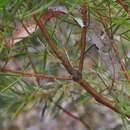pt-BR
nomes no trilho de navegação


Hakea laevipes is a shrub in the family Proteaceae. A widespread species found growing on coastal and tableland locations mainly in eastern New South Wales, with scattered populations in south-eastern Queensland.[1]
Hakea laevipes is an erect bushy lignotuberous shrub 0.3–3 m (1–10 ft) high. Branchlets are dark brown densely covered with short soft hairs at flowering time. Leaves are lance shaped tapering at each end to egg-shaped, occasionally spatula-shaped sometimes sickle shaped curving to a point, 5–12 cm (2–5 in) long and 4.5–30 mm (0.2–1 in) wide. The flat leaves have 3–5 longitudinal veins with conspicuous secondary veins. The fruit are broadly three dimensional to egg-shaped 20–30 mm (0.8–1 in) long and 13–21 mm (0.5–0.8 in) wide with a rough warty surface ending at the apex with an obscure beak. Cream flowers appear from October to January.[2]
Hakea laevipes was first formally described in 1919 by Michel Gandoger and the description was published in Bulletin de la Société Botanique de France.[1][3] The specific epithet (laevipes) is derived from the Latin words laevis meaning "smooth", "polished" or "bald"[4]: 722 and pes meaning "foot",[4]: 343 since Gandoger described the species as having a smooth flower stalk. When Gandoger initially named the species he compared it to H. leucopoda and H. incrassans, both synonyms of H. dactyloides. In 1973 John MacGillivray noted that the stalk of the individual flowers on the single specimen were not without hairs but possessing a "subsericeous indumentum", meaning closely pressed silky hairs. Therefore despite its name this species does have hairy flower stalks.[5]
There are two subspecies:
Hakea laevipes is a widespread species growing from the coast to tablelands in N.S.W mostly on sandy soils in dry sclerophyll forest, woodland and heath. It is found to the north of Green Cape and inland to the Warialda and Yetman districts. It also grows also in south-eastern Queensland.[2]
Hakea laevipes is a shrub in the family Proteaceae. A widespread species found growing on coastal and tableland locations mainly in eastern New South Wales, with scattered populations in south-eastern Queensland.